Delicious Rosehip and Apple Jelly has all the flavour of running your palate through a rose garden and orchard. The rosy and appley flavour is complimented by the beautiful deep amber colour of this jewel-like jelly.
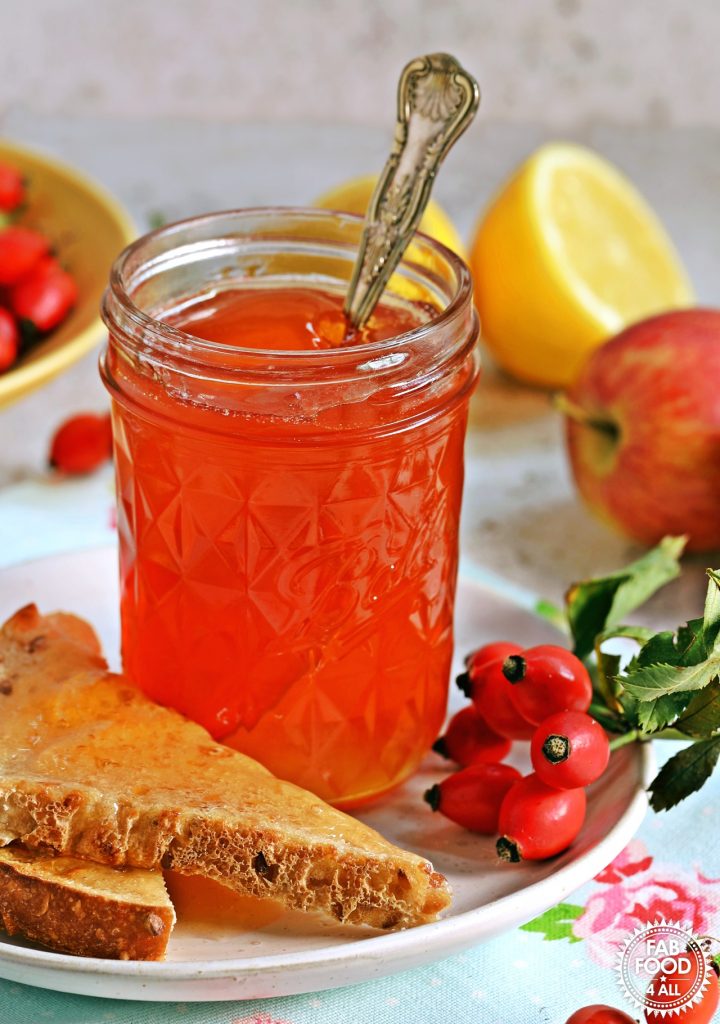
Table of contents
- Why I Made Rosehip and Apple Jelly
- Benefits
- Equipment You’ll Need
- Gathering Ingredients
- Preparing Your Kitchen
- Preparing Ingredients
- How to make Rosehip & Apple Jelly (summary)
- Storing Rosehip & Apple Jelly
- Creative Ways to Enjoy Your Jelly
- Troubleshooting Tips
- Rosehip & Apple Jelly with a Twist
- Sharing and Gifting
- More Preserve Recipes using Rosehips
- More Foraged Fruit Preserve Recipes
- Final Thoughts
Why I Made Rosehip and Apple Jelly
I’ve been walking past rosehips growing in local hedgerows at this time of year, for many years. I knew they could be made into jelly so seeing this year’s glorious crop, I decided to go rosehip picking.
Benefits
- Making Rosehip & Apple Jelly enables you to utilise windfall apples and wild rosehips that grow in hedgerows, roadsides, towpaths, parks, etc.
- It tastes better than anything you can buy in a supermarket and you know exactly what has gone into it!
- Rosehips have up to 20 times more Vitamin C in them than an orange and contain many other nutrients too.
- Rosehips are known to have many medicinal benefits.
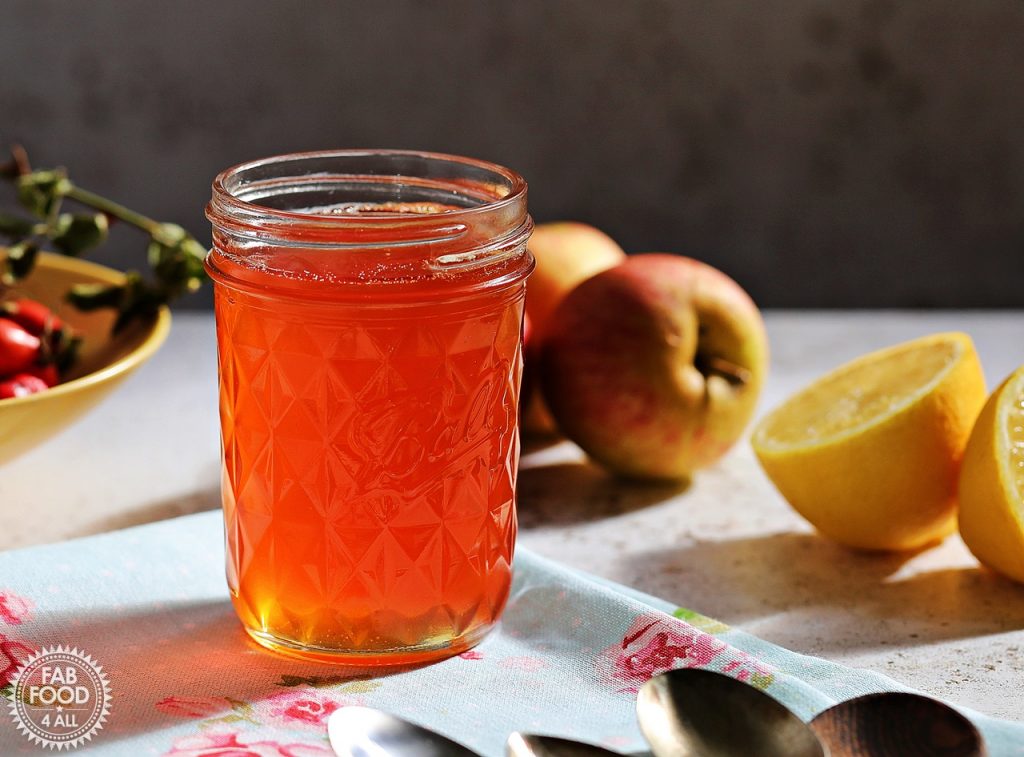
Equipment You’ll Need
- Jelly bag and stand or a way of straining the fruit. I actually bought a jelly bag and plastic stand that you slot together after using a pair of tights tied around a colander for many years. I also tried lining a colander with a muslin cloth but wasn’t happy with this method.
- Preserving pan or similar sized stainless steel pot. I use a large stainless steel soup pot with a heavy base to conduct the heat.
- Digital scales (if you’re in the US and want this recipe in cups I’m afraid you can’t accurately convert a weight to a volume).
- Long wooden spoon for stirring and preventing jelly from sticking to the bottom of the pan.
- Large metal spoon for skimming any scrum/foam off the surface.
- Glass bowl – metal reacts to fruit acid (and can alter the flavour) so it’s best to use a non-reactive bowl like glass or ceramic.
- Sharp paring knife – unfrozen rosehips are quite tough to cut, but much easier if frozen.
- Chopping Board – for cutting up fruit.
- Ladle – for adding cooked fruit mixture to jelly bag.
- Saucers for cold plate set test.
- Jam funnel – for mess-free potting up of jelly.
- Jam jars and lids – 7 x 240 ml (8 ounce) capacity or jars sizes of your choice. This recipe makes just over 6 jars but it’s always best to sterilise more than you think you need.
Gathering Ingredients
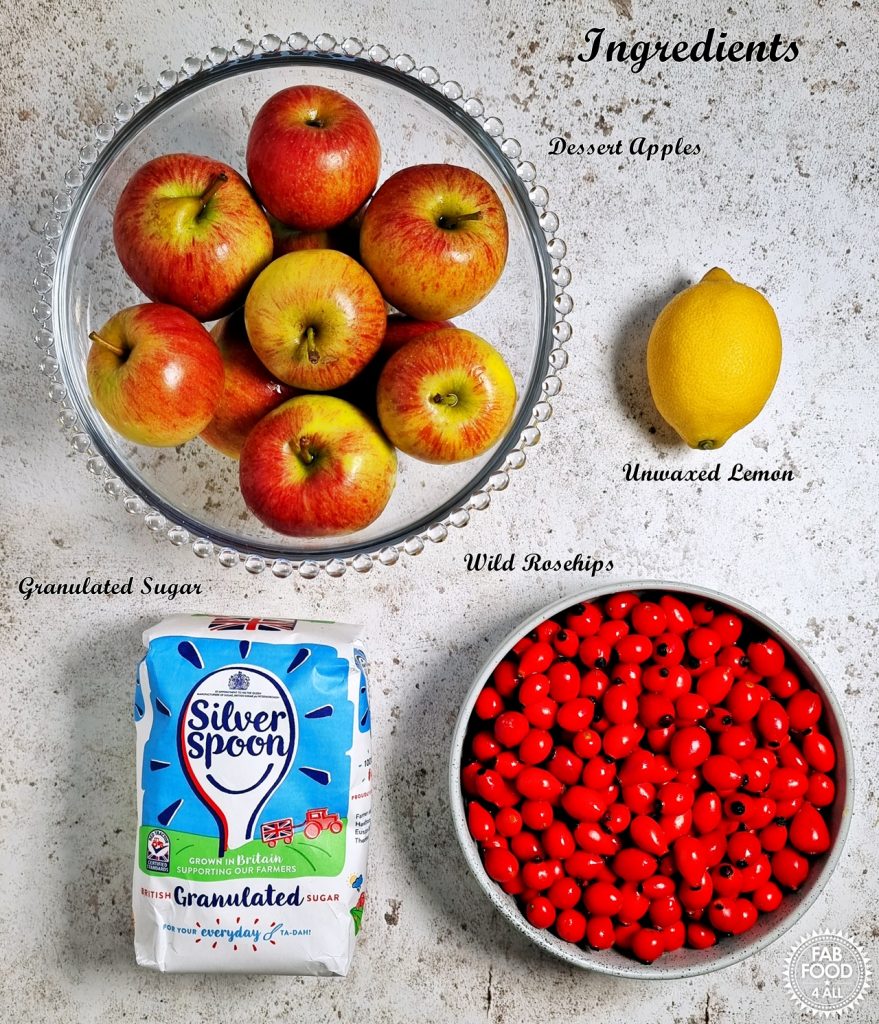
There are just 4 ingredients in this Rosehip and Apple Jelly which are wild rosehips, apples, lemon and granulated sugar (plus cold water).
Selecting Fresh Rosehips
Rosehips or rose hips are the fruits of rose plants. Ripe rosehips are usually red to orange in colour and are ready to pick in the autumn.
They are best picked when firm looking or with a slight give but not crinkly or mushy.
It’s said that it’s best to pick rosehips after the first frost as this makes them sweeter. However, rosehips can start spoiling before then so you can replicate this by popping them in your freezer.
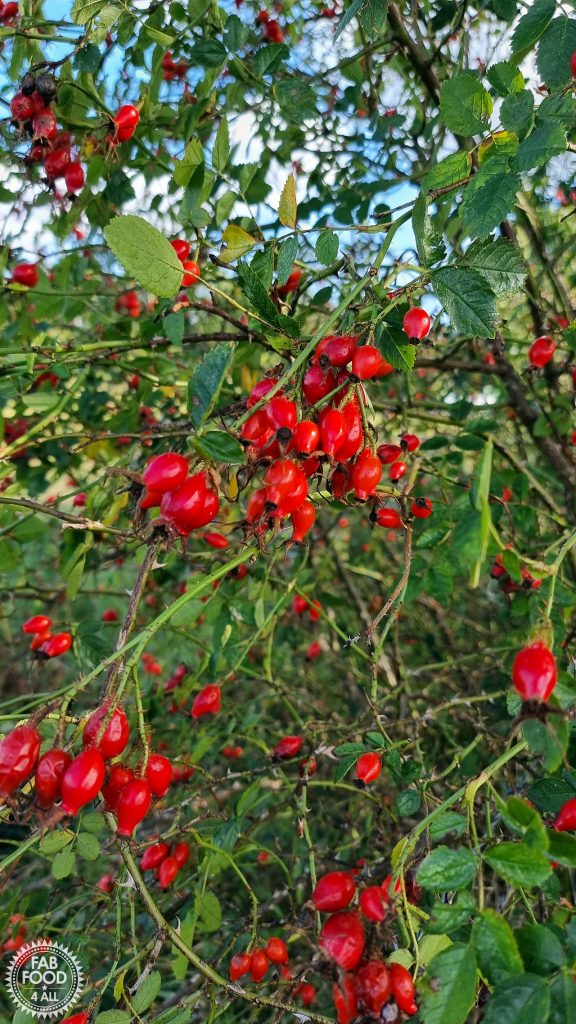
To put this theory to the test I actually tried frozen and non-frozen rosehip flesh on TikTok and the frozen ones had a far more intense flavour. Plus, the flesh goes mushy as the cell walls are broken down by the freezing process so that will make them render more juice and colour.
I have to admit that I intended to freeze mine, but time didn’t allow! So don’t worry if you find yourself in the same boat, my rosehip jelly tasted great!
Wild rosehips (like those from the Dog Rose) are best for jelly making as they are richer in Vitamin C than garden rosehips. All rosehips are edible but you should avoid roses that have been sprayed with pesticides.
Tips for Harvesting Rosehips

The first time I went rosehip picking I came away with badly scratched hands and muttered a few choice words!
So, a few days later I went better prepared with a long-sleeved jacket, gardening gloves, secateurs and a paper carrier bag (plastic or fabric gets caught in thorns).
You can either pull the hips off the stems with a twist or snip clusters with secateurs or scissors.
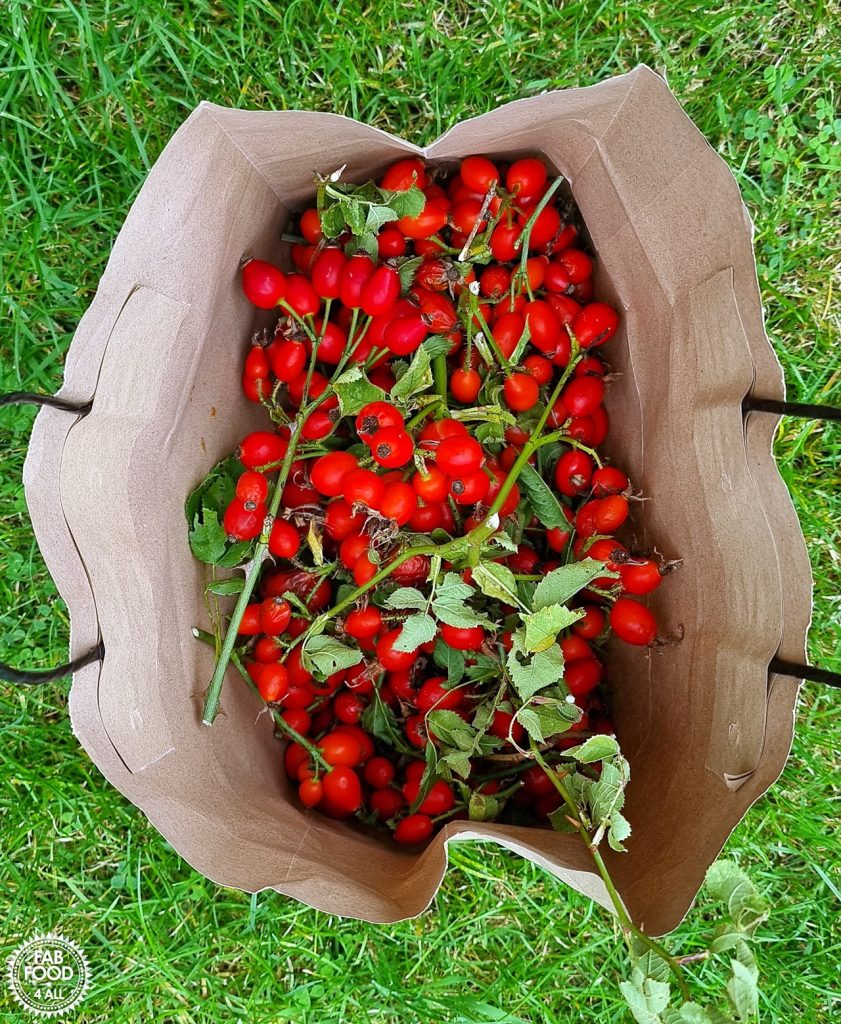
Choosing the Right Apples
I decided to pair my wild rosehips with sweet Braeburn dessert apples after a trial run with Bramley apples (cooking apples).
Wishing to cook the rosehips and apples in the same pan for the same amount of time I found that dessert apples were a better choice. Bramley apples went mushy way before the rosehips were cooked.
Any dessert apple will work well and you could also use crab apples which will give a deeper red colour.
Additional Ingredients
For an additional boost of pectin, I add an unwaxed sliced lemon. Ripe dessert apples aren’t as high in pectin as freshly picked or Bramley apples.
The final ingredient is granulated white sugar. The amount of sugar is calculated once you know how much juice your boiled rosehips and apples have rendered. It’s 450 grams of sugar per 575 mils or juice which is 78% of the total juice measurement. I just asked Google to do the calculation.
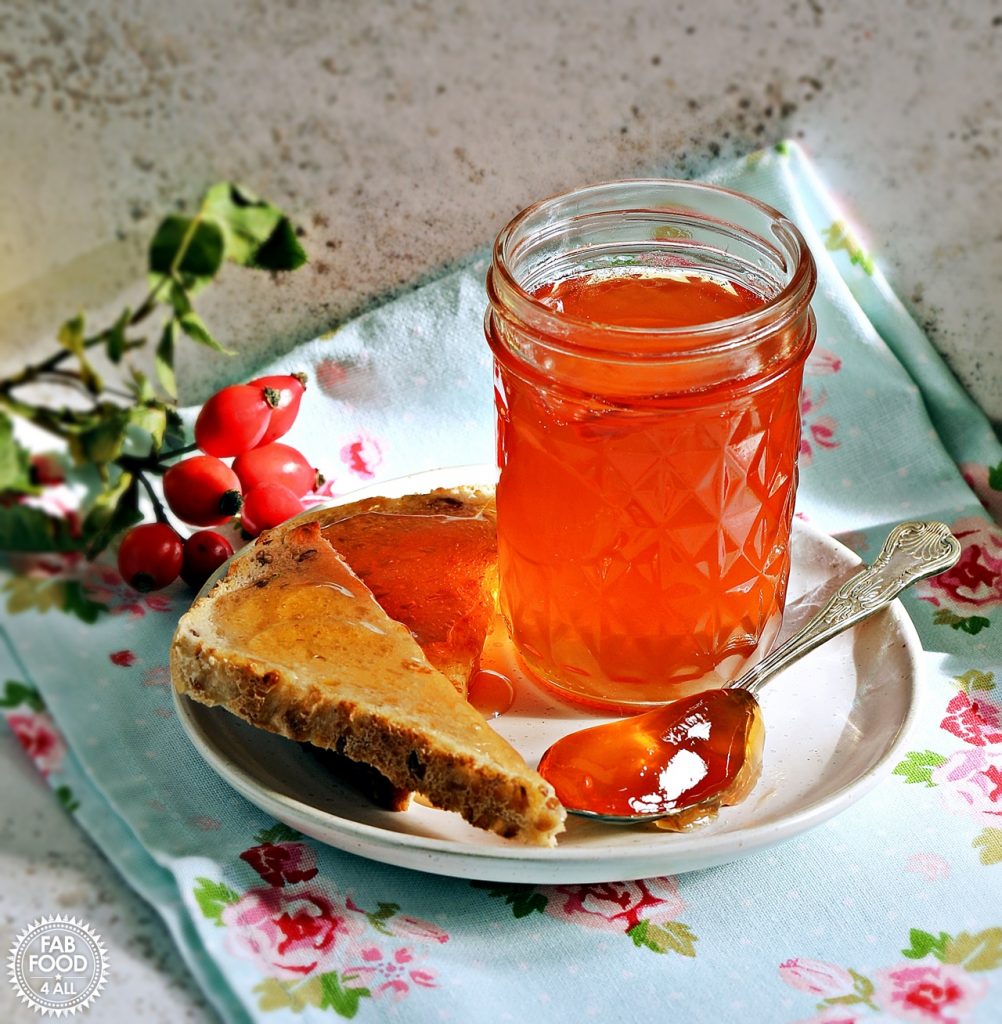
Preparing Your Kitchen
Cleaning and Sterilizing Equipment
Start by sterilising your jars and lids. To do this first wash in hot soapy water (or take straight from your dishwasher). Then for the jars, fill them with boiling water and place them on a baking tray in a preheated oven at 140°C (fan 120°), 285°F.
Washed lids should be put in a bowl and covered in boiling water. Then remove with tongs and stand up on a sink drainer or lay on a clean tea towel.
Whatever you’ll be using to strain the jelly eg jelly bag, muslin, cheesecloth or tights also needs to be sterilised by immersing it in boiling water.
Setting Up Your Workspace
Be sure to set up your jelly bag and stand (or whatever you’re using) in a place where it won’t be disturbed or knocked over. I covered my jelly bag with a tea towel to prevent any inquisitive fruit flies.
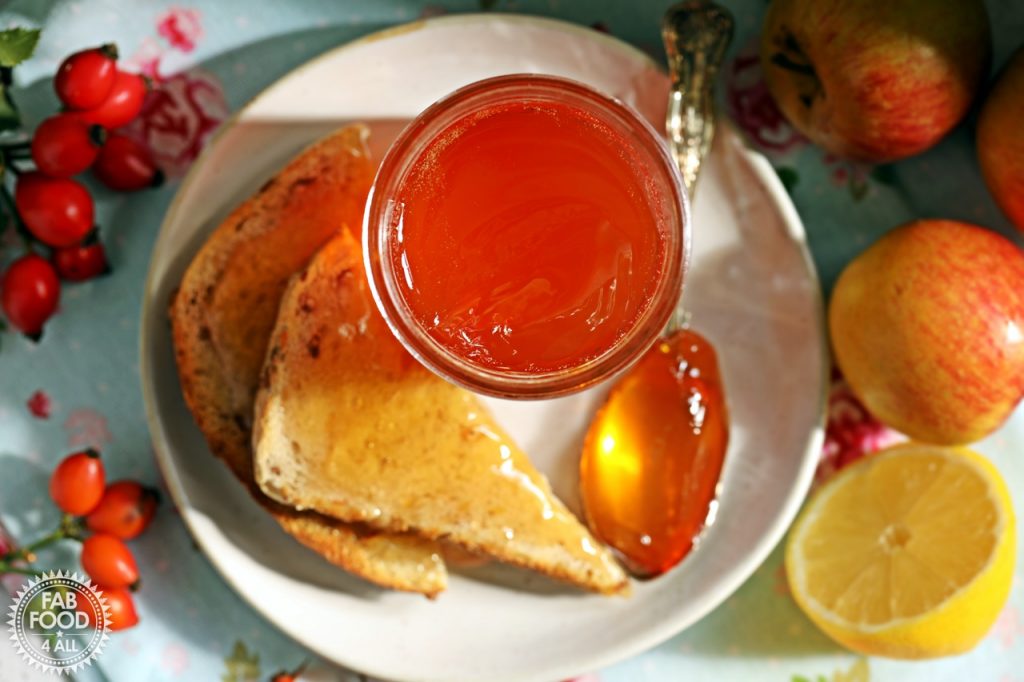
Preparing Ingredients
Cleaning and Trimming Rosehips
Prepare the rosehips by removing any stems and loose dead leafy bits (tufty ends can stay).
Then wash by immersing in cold water and agitate to rid rosehips of any insects or loose detritus. Rinse and repeat until the water runs clear.
I found a large salad spinner perfect for this job.
Then cut the rosehips in half with a sharp knife. (Some recipes say to use a food processor but I don’t like the idea of the fine seed hairs being chopped up and going through the jelly bag as they’re an irritant). Just call me cautious!
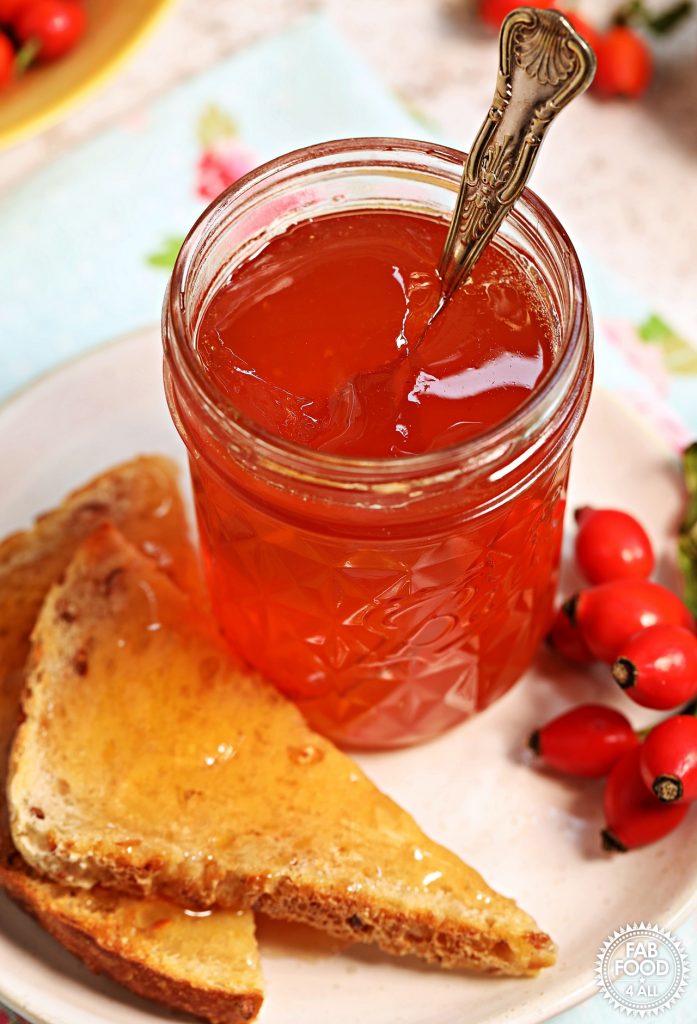
Prepping Apples
The apples should be cut in half and then each half cut into 4 to 6 chunks, depending on size. No need to peel or core the apples but I did remove the stems.
Lemon Prep
Some recipes call for lemon juice but I like to add the whole lemon, sliced, as the skin, pith and pips are where you’ll find the pectin and the juice also aids the gelling process.
Warming Sugar
While your jars are sterilising in the oven you should add your sugar to a baking tray to warm through for about 15 minutes. This will make the sugar dissolve faster in the juice and save some stirring.
How to make Rosehip & Apple Jelly (summary)
- Add water, lemon slices, chopped apples and rosehips to a preserving or large pan.

- Bring to a boil and then simmer until the fruit is pulpy (use a potato masher as the fruit softens).

- Allow cooked the fruit to rest for 10 minutes and then ladle the pulpy liquid into a jelly bag (or your choice of strainer).

- Leave to drip overnight.

- The next day measure your juice and calculate the amount of sugar you’ll need. You need 450 grams of sugar per 575 millilitres of juice (78%, just ask Google).

- Pour the juice and warmed sugar into a clean preserving pan and dissolve the sugar over a low heat whilst stirring with a wooden spoon.

- Once the sugar has dissolved, increase the heat to maximum and bring it to a rolling boil whilst stirring until the setting point is reached. This is around 19 minutes or when the temperature on a digital or sugar thermometer reaches 105°C.

- Remove pan from heat and test for set by pouring a little jelly onto a chilled saucer and pop in the fridge for 30 seconds. It should wrinkle when a finger is pushed through it. If not ready, repeat boiling and testing until wrinkle forms.

- Pot up into prepared jars with a jam funnel and ladle.

- Seal with lids immediately.

Storing Rosehip & Apple Jelly
Rosehip & Apple Jelly should be kept in a cool, dark place for up to 12 months. After this time, it’s still safe to eat but the colour will deteriorate. I have eaten Crab Apple Jelly after 2 years and it was still delicious.
Once open, store jelly in the fridge where it will keep for many months.
Creative Ways to Enjoy Your Jelly
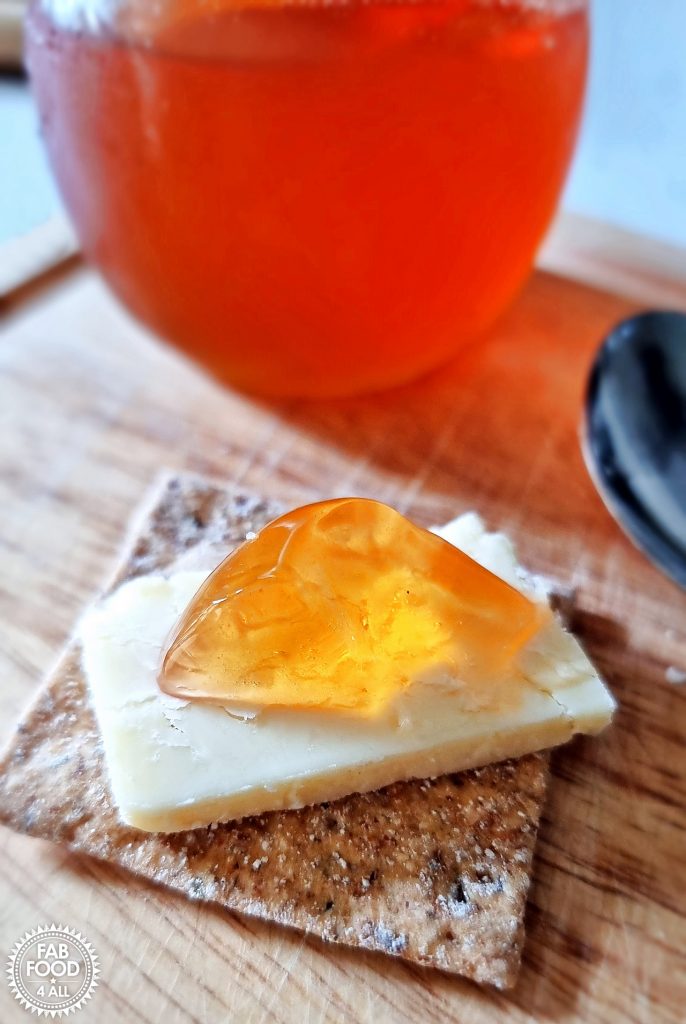
There are so many ways to use Rose Hip Jelly eg:
- Spread on sourdough bread, toast, scones, croissants etc.
- Serve with cheese and crackers (so good).
- Swirl into yogurt, porridge, semolina pudding, etc.
- Use as a condiment with savoury dishes, roasts or cold meats.
- Glaze roast meats such as gammon.
- Stir into gravy.
- Add to baked goods such as cakes, cookies and puddings.
- Use in a cocktail.
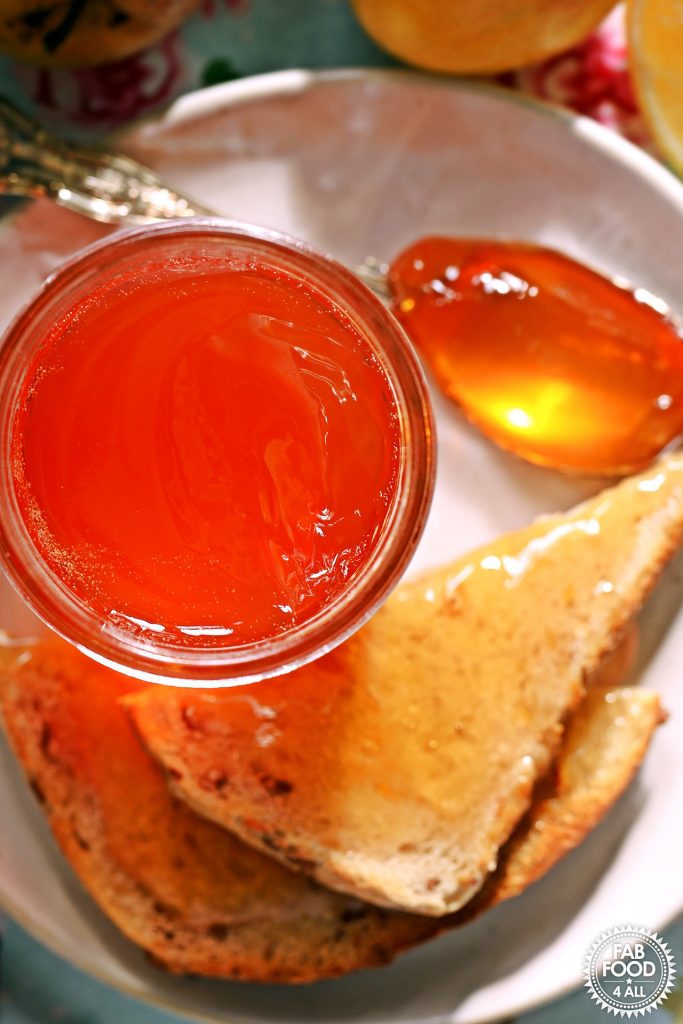
Troubleshooting Tips
Common Jelly-Making Issues
- Don’t be tempted to squeeze the jelly bag or your jelly will be cloudy and not beautifully clear.
- Never rush the straining time, you need to leave the cooked fruit to drip overnight to get all the juices out.
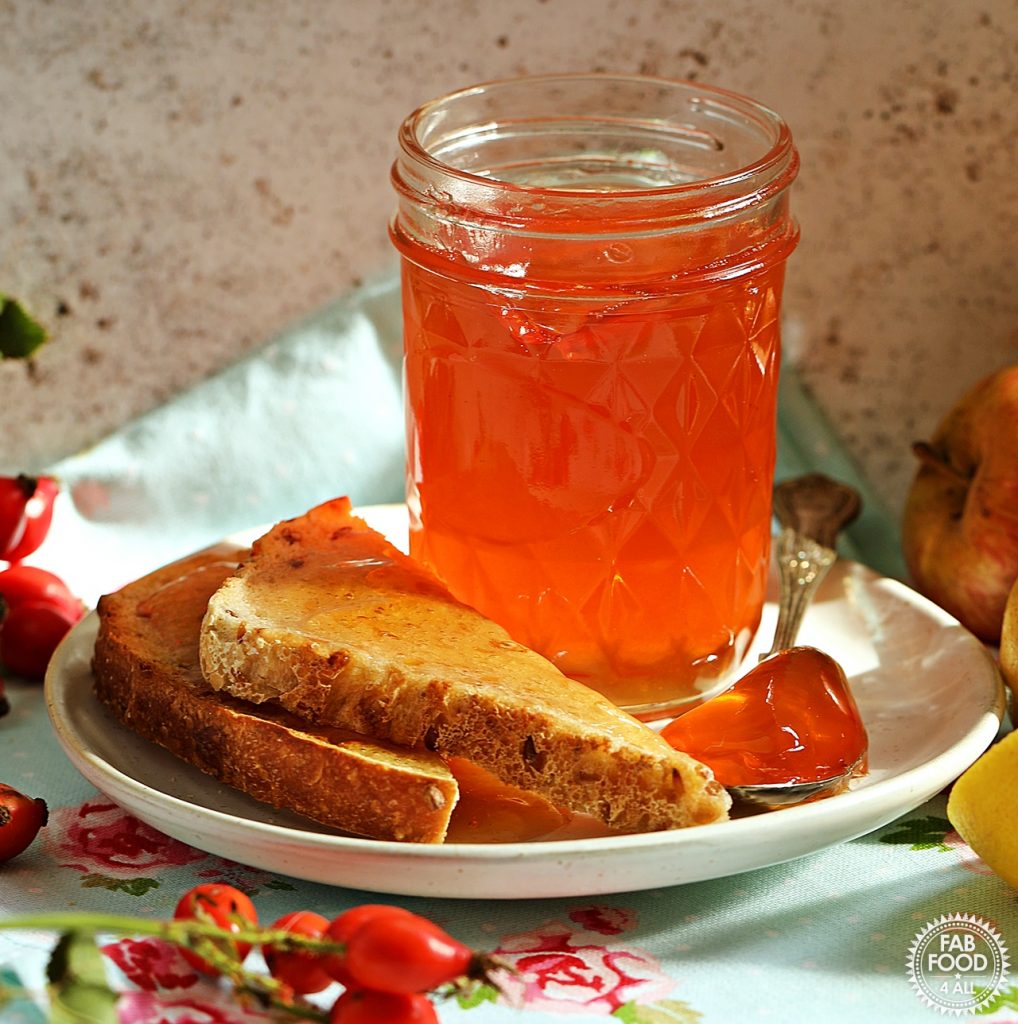
How to Fix Rosehip Jelly Making Problems
Add some boiling water and re-boil until the setting point is reached.
This shouldn’t happen if you’ve done the chilled plate test but if it does, then empty your jars back into a clean pan and re-boil until the setting point is reached.
A great way to test the progress of your jelly is to scoop up a spoonful of the boiling jelly on a wooden spoon and let it pour off. If the last drip hangs down and stays suspended on the spoon then you know it’s time to do the plate test.
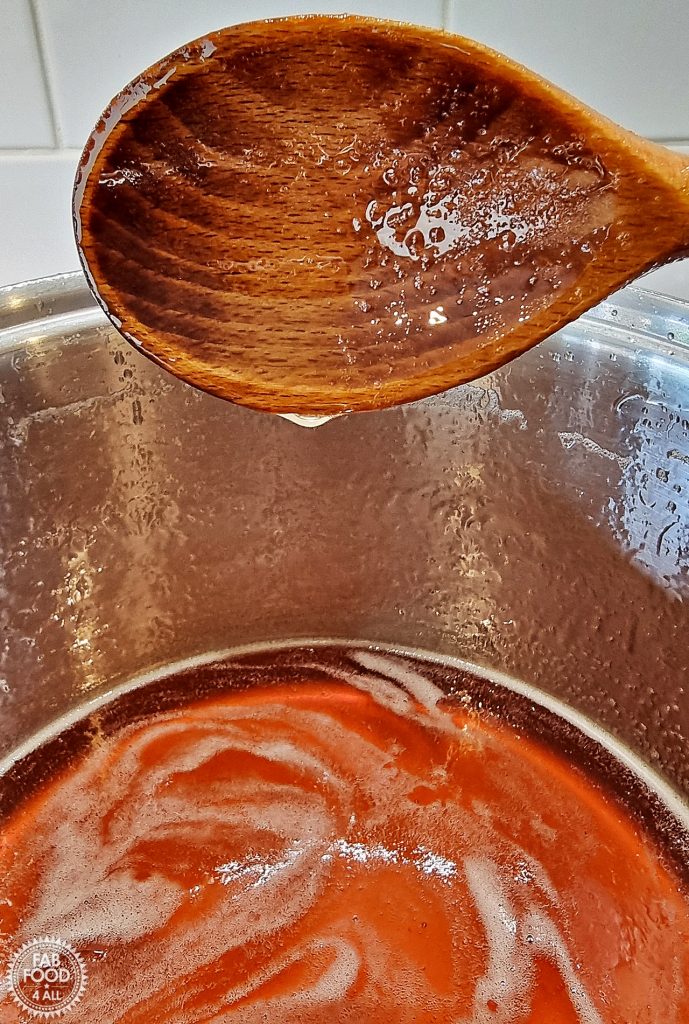
Rosehip & Apple Jelly with a Twist
If you want to ring the changes then you could add a stick of cinnamon and or cloves to the rosehips and apple at the cooking stage. Best not to add ground spices as these will result in cloudy jelly.
Sharing and Gifting
Homemade jelly makes a great gift and if you have children, you can get them involved in making pretty labels and covers for the jars.
Jam jar covers can be made from old fabric cut with pinking shears, and then tied with string or a ribbon.
Plain sticky labels can be decorated with felt tip pens and then written on with a calligraphy pen.
More Preserve Recipes using Rosehips
Here are some great recipes from fellow food bloggers:
More Foraged Fruit Preserve Recipes
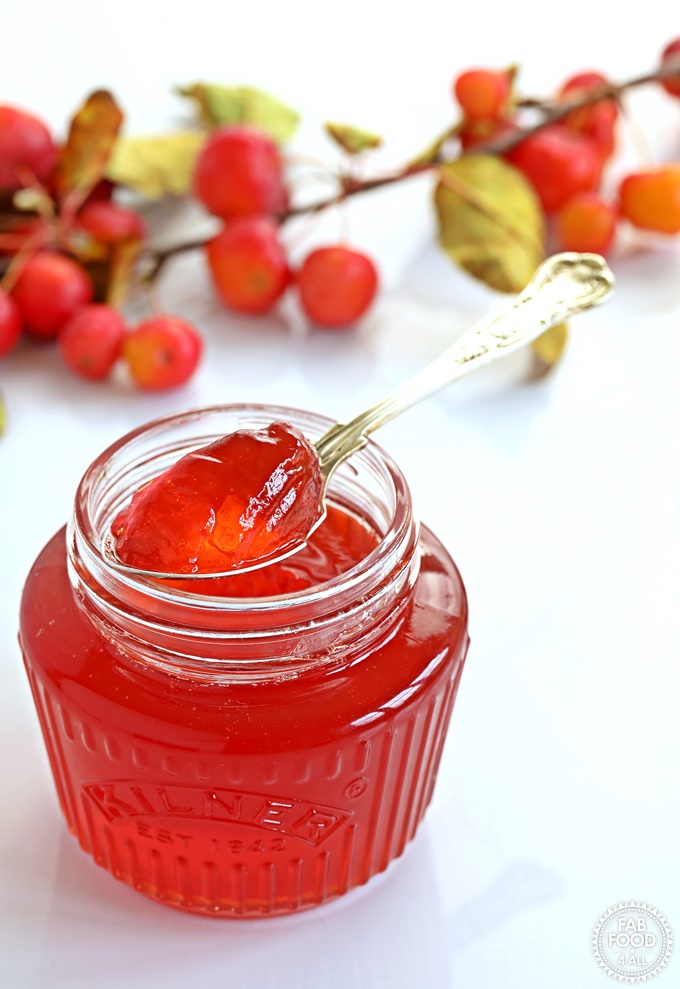
- Crab Apple Jelly
- Easy Blackberry & Apple Jelly
- Sloe & Apple Jam
- Mirabelle Plum Jam
- Easy Blackberry & Apple Jam
- Easy Seedless Blackberry Jam
- Simple Elderberry Jam
- Easy Blackberry Curd
- Easy Lemon & Elderflower Curd
Final Thoughts
I really hope you get out into the fresh air and forage for rosehips to make this Rosehip & Apple Jelly. Not only is it good for your physical health but foraging is great for your mental health.
Anything you enjoy doing releases cortisol and that boosts your immune system (which is probably why I’m addicted to making jams and jellies)!
Leave a comment and rating below when you’ve made this recipe; I love getting your feedback! You can also share your pictures by tagging @FabFood4All over on Instagram.
Pin for later!
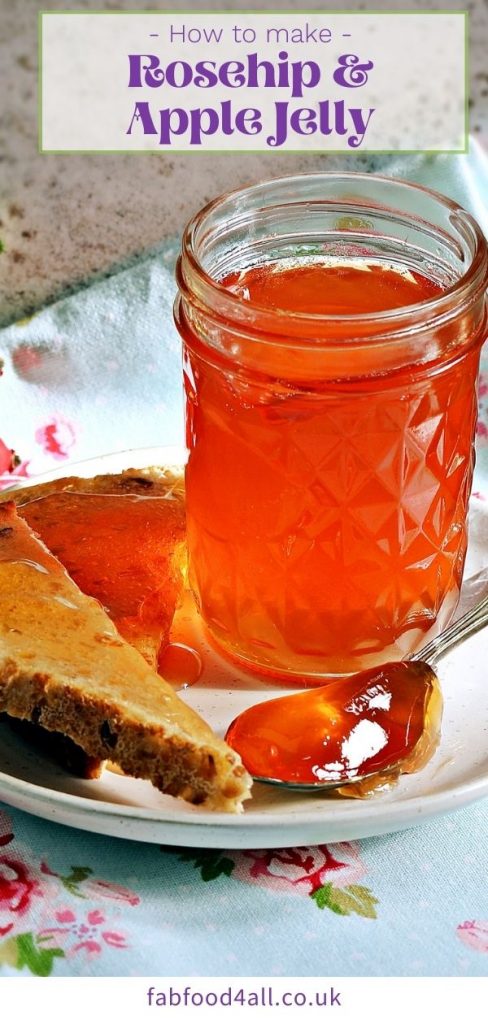
How to Make Rosehip & Apple Jelly
Equipment
- 1 Digital scales
- 1 Preserving pan or similar sized pan
- 1 Sharp paring knife
- 1 Chopping Board
- 1 ladle
- 1 long wooden spoon
- 1 Large metal spoon
- 1 Glass or ceramic bowl
- 1 Jelly bag and stand (or sieve/colander lined with muslin, cheesecloth or tights).
- 1 jam funnel
- 1 7 x 240 ml jam jars & lids (or equivalent)
Ingredients
- 1 kilogram dessert apples washed, quartered and cut into chunks, don’t peel or core but remove stems.
- 500 grams prepared wild rosehips halved (stems and loose leafy bits pulled off and washed thoroughly)
- 1 unwaxed lemon sliced
- 1.1 kilograms granulated sugar warmed – see notes (approximately, see method for calculation)
- 1.8 litres cold water
Instructions
- Before you start, place 2 – 3 saucers in the freezer and sterilise jars (see notes).
- Pour 1.8 litres of water into a preserving pan and add the lemon slices, chunks of apple as you prepare them (to prevent browning) and the halved rosehips.
- Bring to a boil, then lower the heat to a simmer until fruit is cooked (use a potato masher to break up the apples as they soften). This will take up to 30 minutes.
- Once cooked, allow pulpy mixture to rest for 10 minutes then ladle into a jelly bag (or whatever you’re using).
- Leave the mixture to strain overnight (covering with a clean tea towel).
- The next day, measure the amount of fruit juice produced and calculate the amount of sugar you will need. You’ll need to add 450 grams of sugar for every 575 millilitres of fruit juice. (Just ask Google for 78% of the amount of fruit juice you have and that’s how much sugar in grams you need). I had 1.415 litres of juice so needed 1.1 kilograms of sugar.
- Pour juice and sugar into cleaned preserving pan and stir until dissolved over a low heat (do not allow to simmer or you’ll get gritty jelly).
- Once sugar has dissolved (no crunching sounds when stirring), bring mixture to a rolling boil, stirring constantly, until setting point is reached. This was around 19 minutes for me. You can use the drip test to gauge when the pan is ready to come off the boil (see copy above). You can also use a digital or sugar thermometer which should reach 105°C (but I found setting point actually went to 106°C or more).
- Test for set. Remove pan from heat and pour a few drops of jelly on a chilled saucer and place in fridge for 30 seconds. Run your finger through the jelly and if it wrinkles, it’s ready. If not, place back on a rolling boil for another minute or 2 and keep testing until jelly passes the test.
- Move any scum to one side of the pan and skim off with a large metal spoon.
- Then pot up into hot sterilised jars using a ladle and jam funnel (if you have one). Screw lids on immediately.
- Makes just over 6 small jars.
- Once cool store in a cool, dry, dark place.
Video
Notes
Clean jelly bag, muslin, cheesecloth or unworn tights should be sterilised by pouring hot water onto them in a bowl.
Whilst jars are warming spread sugar out on a baking tray and warm through for about 15 minutes.
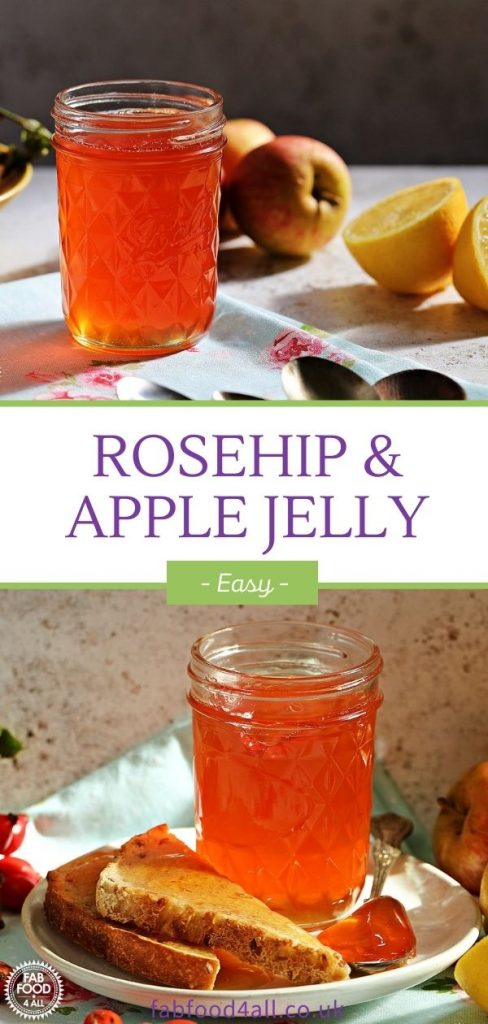
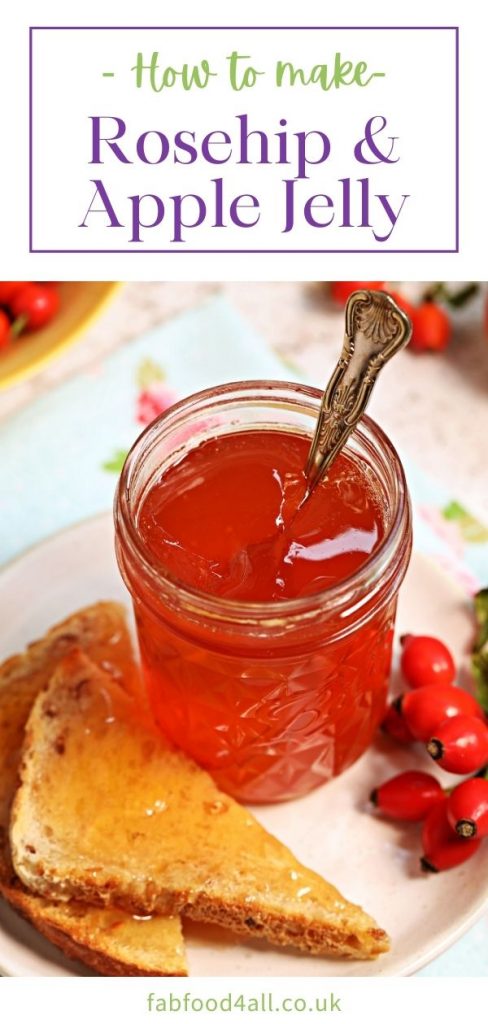
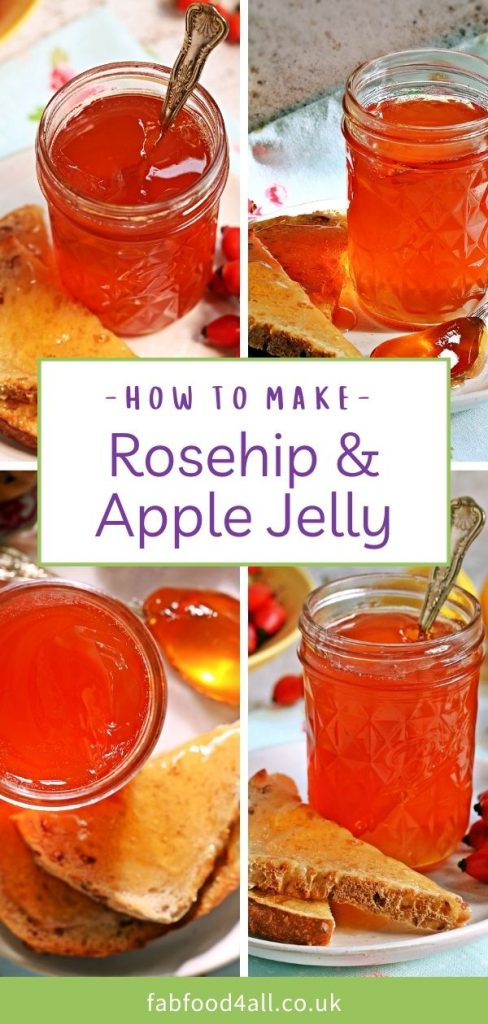
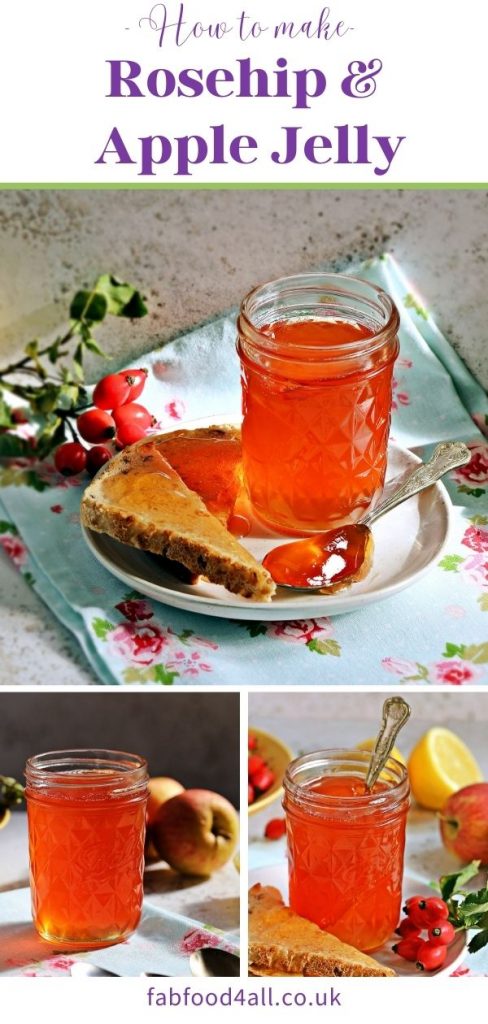
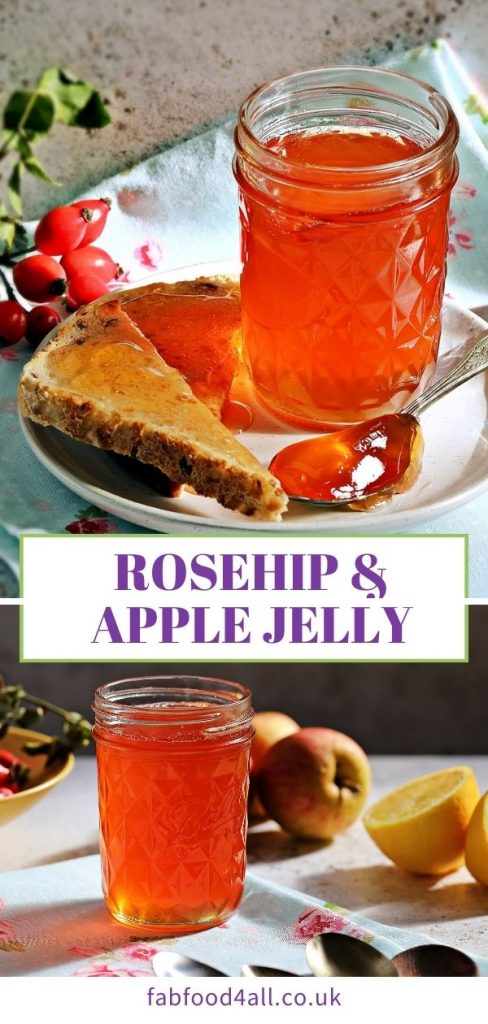
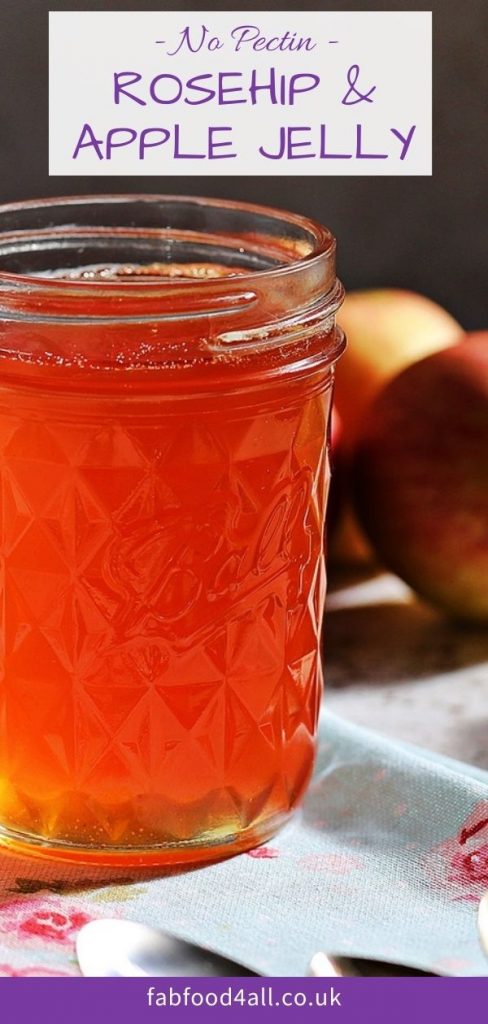
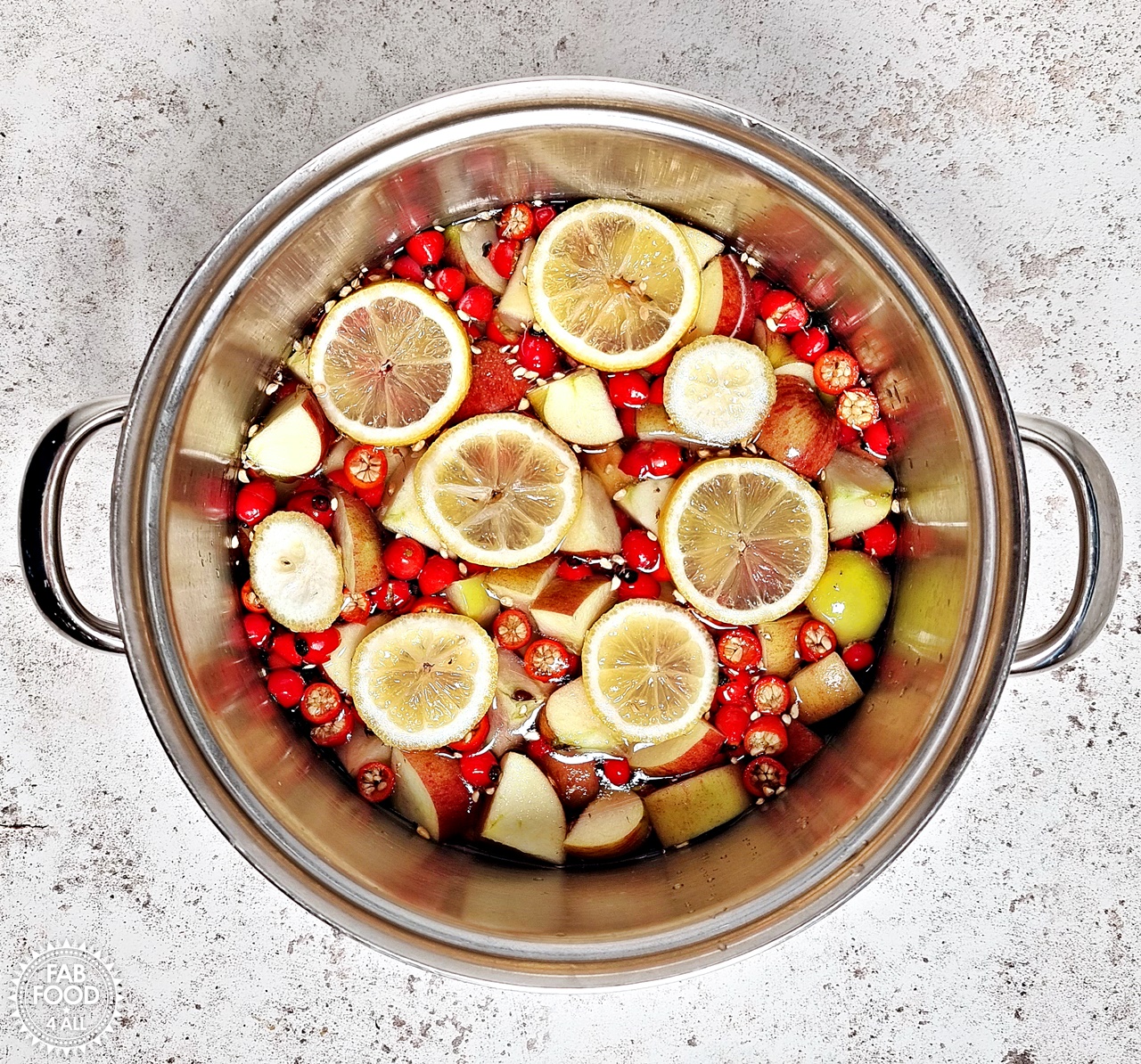
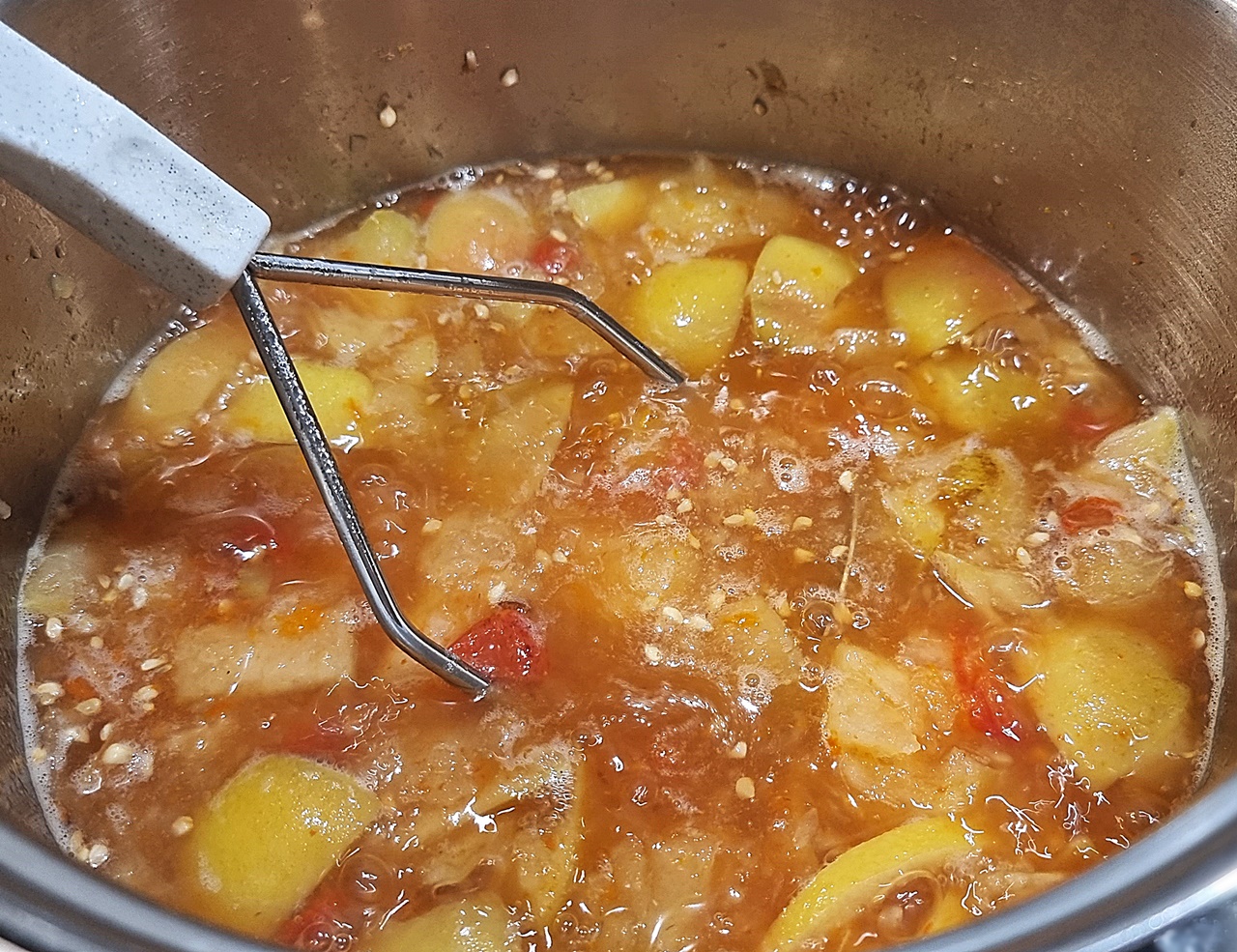
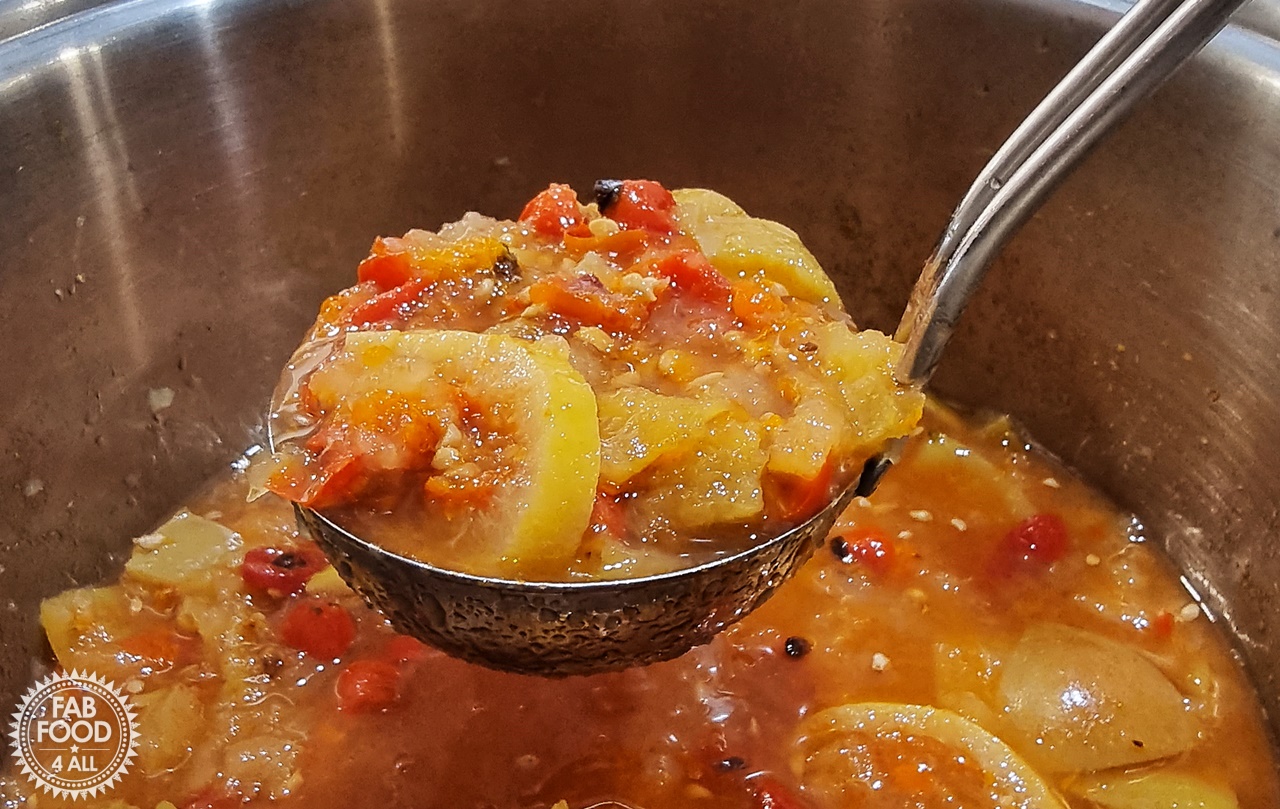
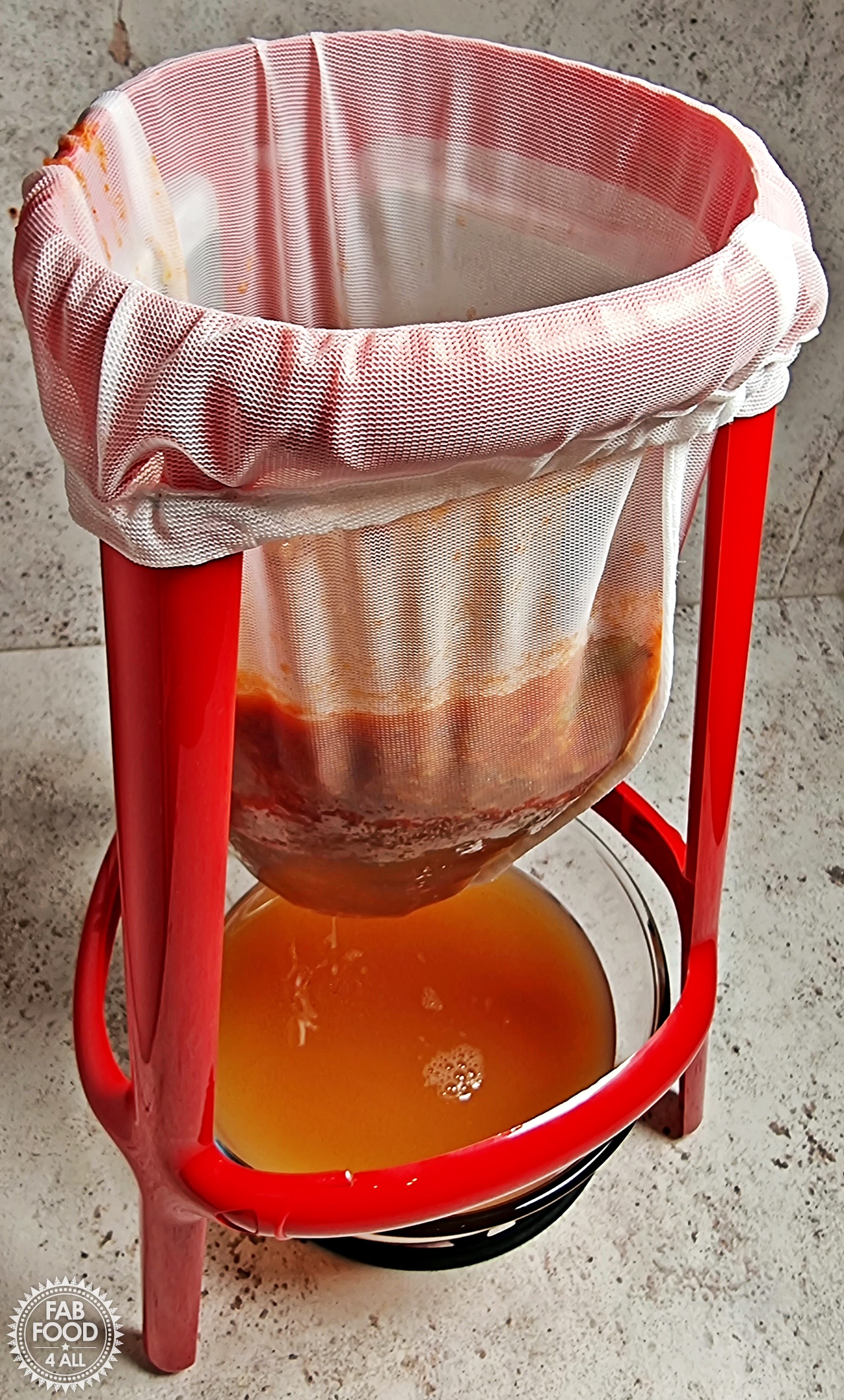
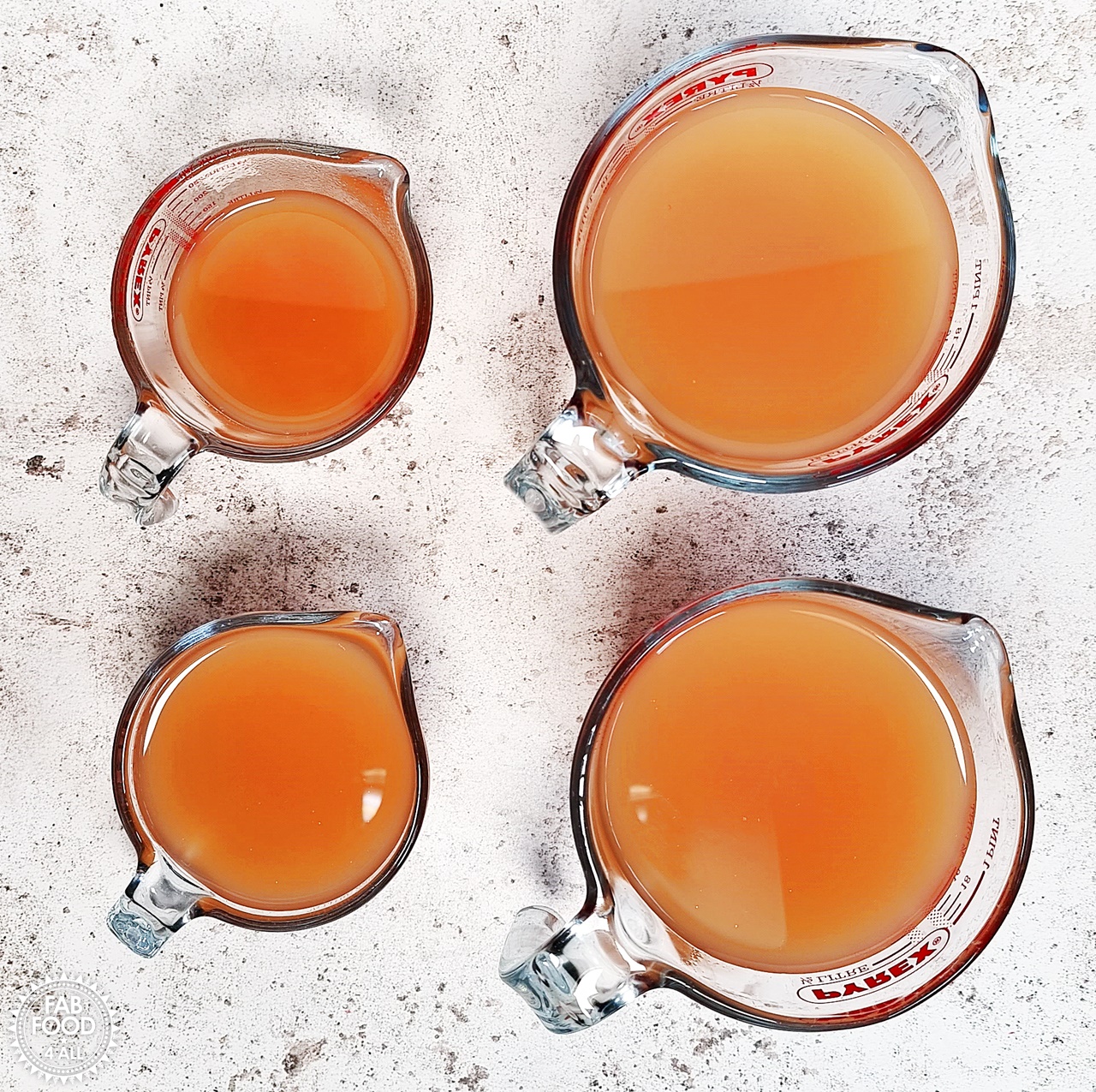
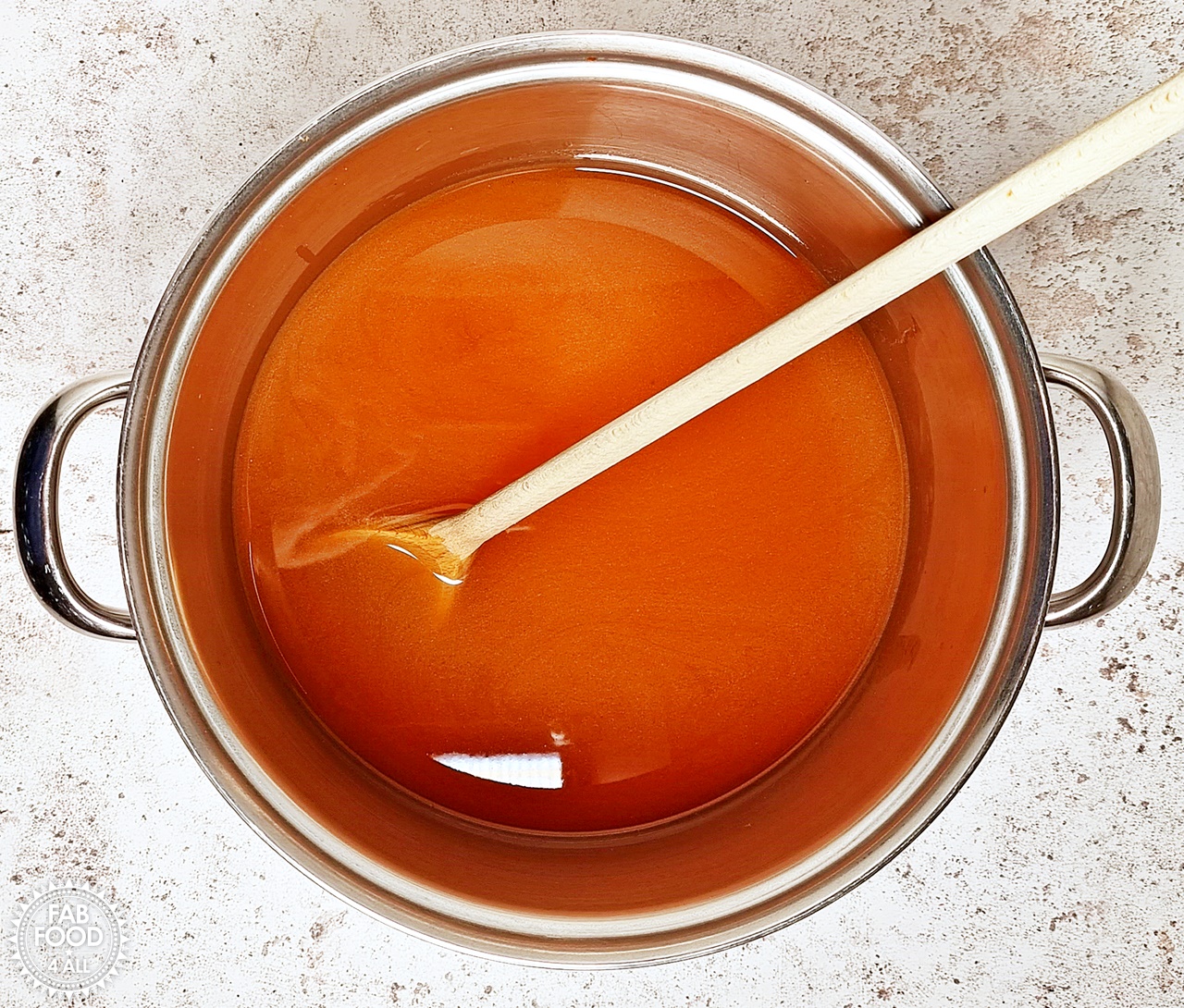
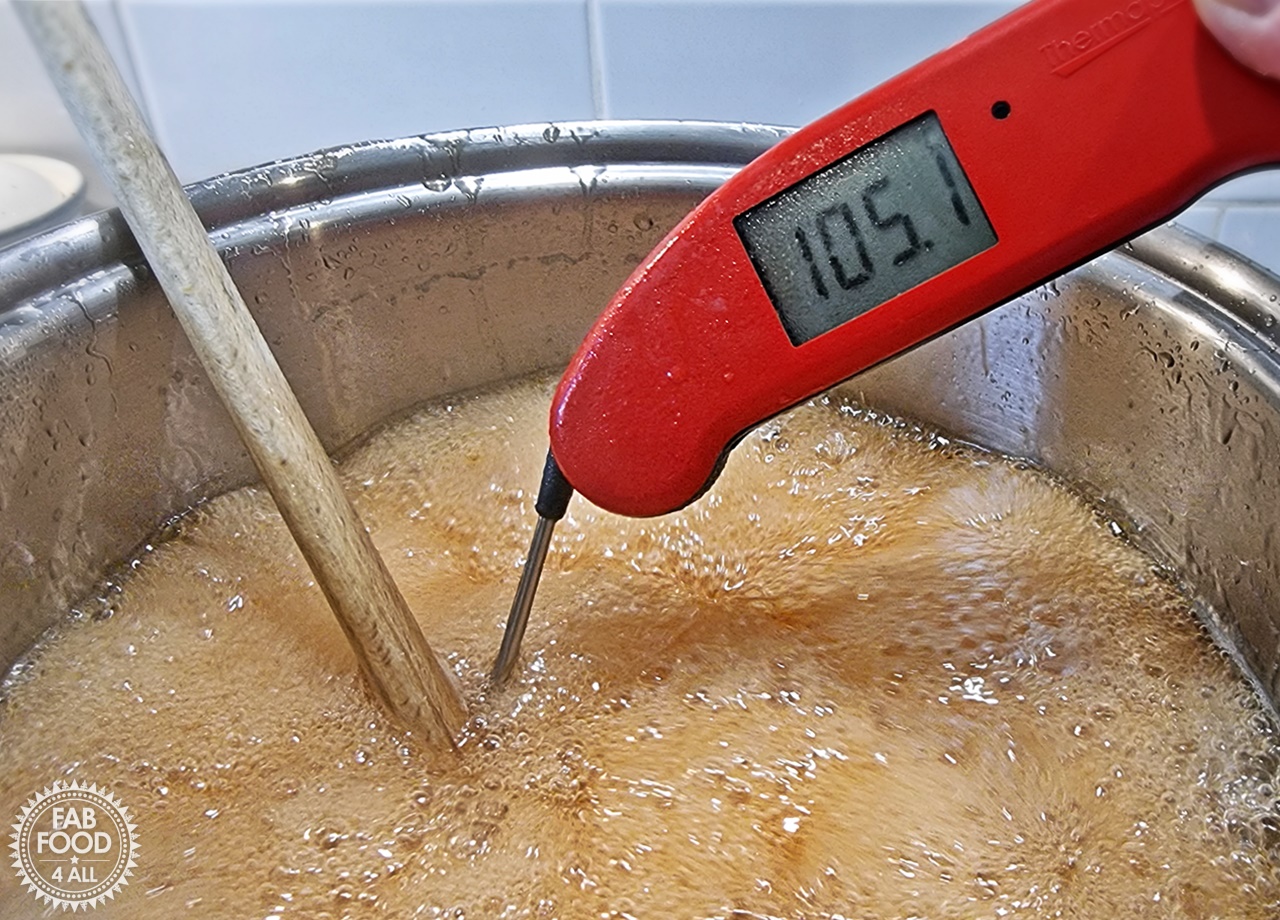
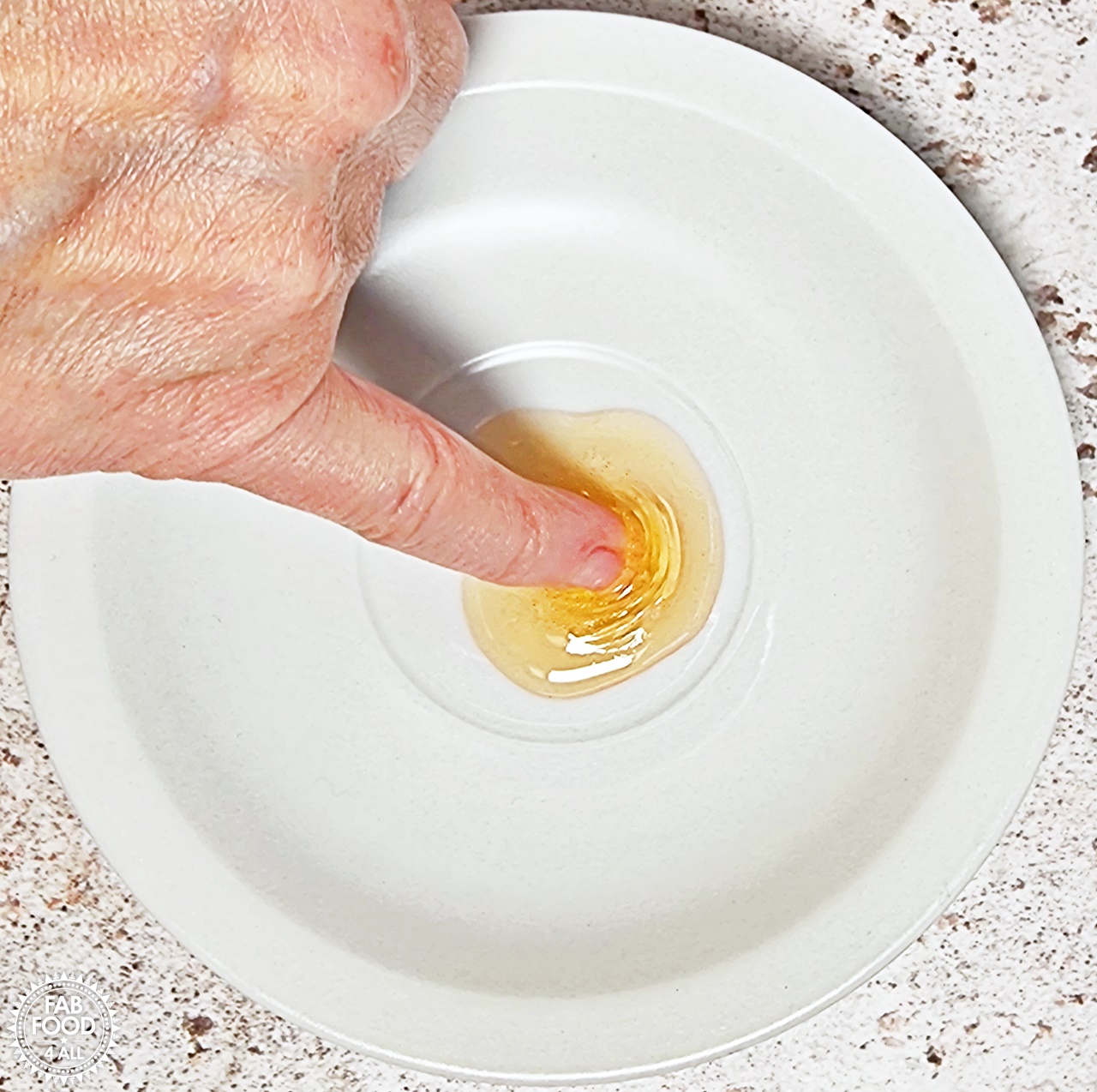
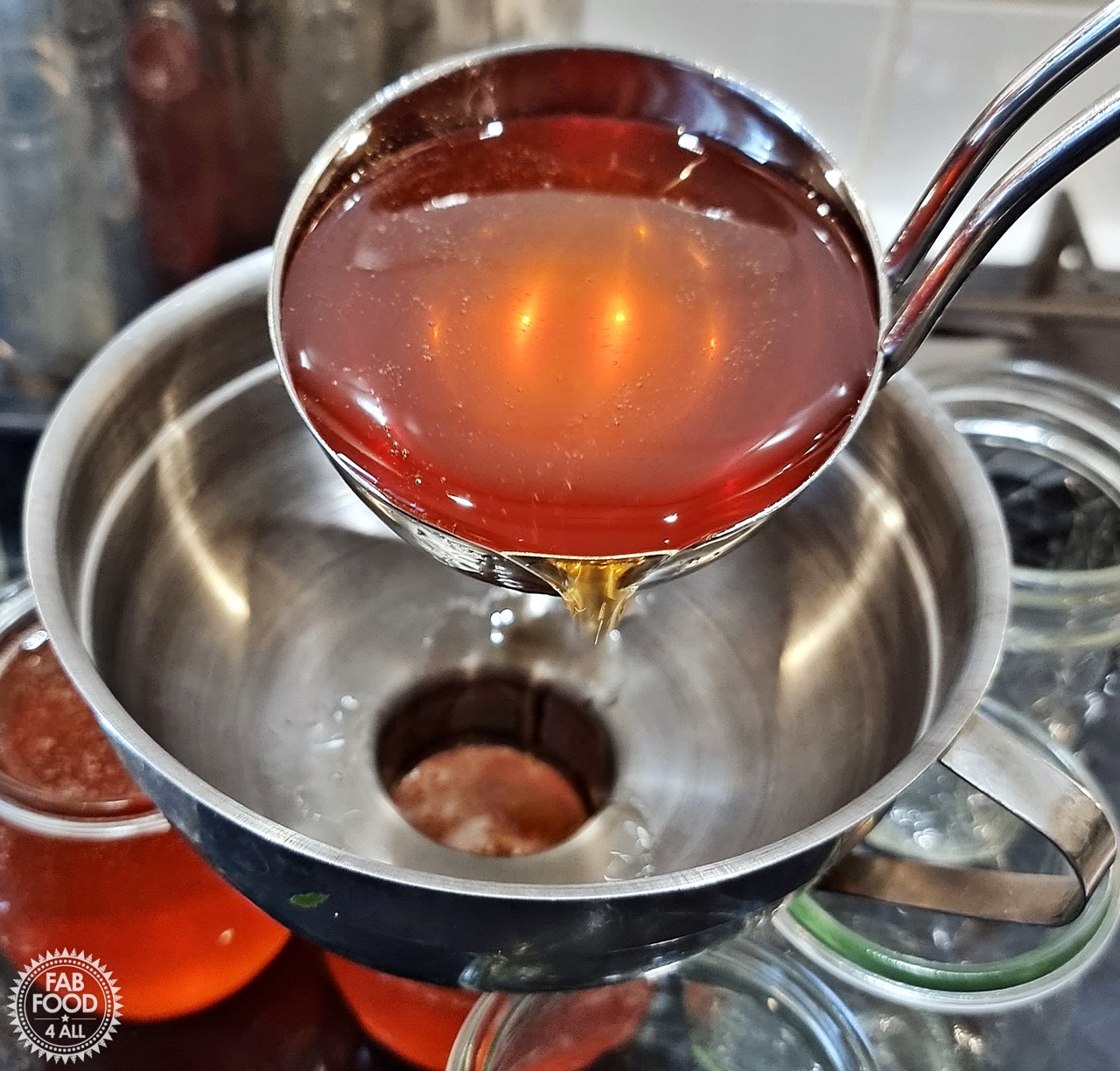
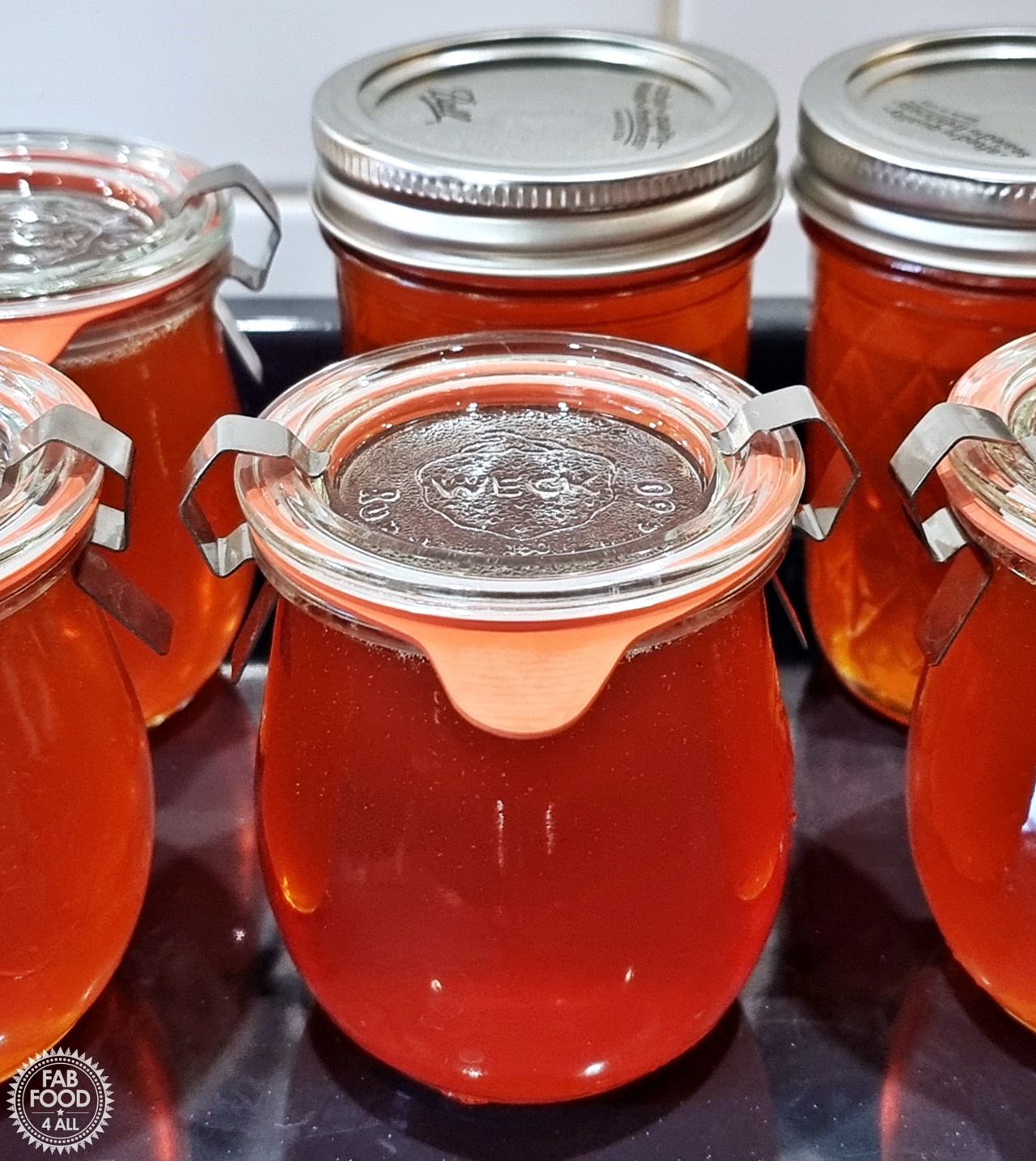
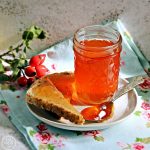
Janice
Rose hips have been particularly good this year. This is the perfect way to preserve them.
Camilla
Thanks Janice. I’ve never picked them before but I didn’t have to try very hard or go very far, they were so abundant:-)